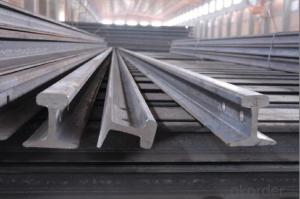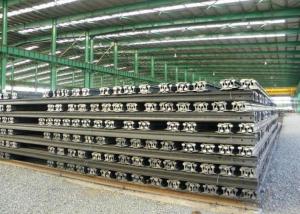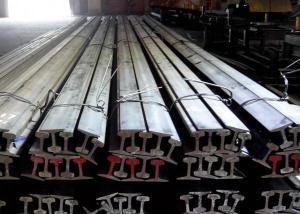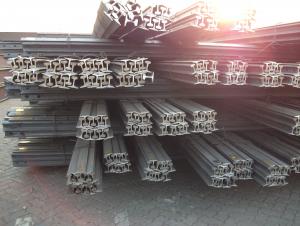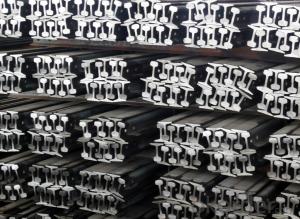Mild Steel Light Rail 55Q
- Loading Port:
- China Main Port
- Payment Terms:
- TT or LC
- Min Order Qty:
- 50 m.t.
- Supply Capability:
- 5000 m.t./month
OKorder Service Pledge
OKorder Financial Service
You Might Also Like
Product Description:
OKorder is offering Mild Steel Light Rail 55Q at great prices with worldwide shipping. Our supplier is a world-class manufacturer of steel, with our products utilized the world over. OKorder annually supplies products to African, South American and Asian markets. We provide quotations within 24 hours of receiving an inquiry and guarantee competitive prices.
Product Applications:
Mild Steel Light Rail 55Q are ideal for structural applications and are widely used in forest region, Mines, factories and construction sites laid of the place such as temporary transport line and light motorcycles with line.etc.
Product Advantages:
OKorder's Mild Steel Light Rail 55Q are durable, strong, and wide variety of sizes.
Main Product Features:
· Premium quality
· Prompt delivery & seaworthy packing (30 days after receiving deposit)
· Mill test certification
· Professional Service
· Competitive pricing
Product Specifications:
Manufacture: Hot rolled
Grade: Q235, 55Q
Certificates: ISO, SGS, BV, CIQ
Length:6m, 12m,12.5m
Package: Packed in bundles and shipped by break bulk or containers.
Trademark | Rank | Chemical composition (quality score) % | |||||
C | Si | Mn | S | P | |||
≤ | ≤ | ≤ | |||||
Q235 | A | 0.14-0.22 | 0.30 | 0.30-0.65 | 0.050 | 0.045 | |
Q235 | B | 0.12-0.20 | 0.30 | 0.30-0.70 | 0.045 | 0.045 | |
Trademark | Rank | Pulling Test | |||||
Bend PointΔs/Mpa | Tensile Strength | Elongation Ratioδ5% | |||||
Thickness (Diameter) /MM | Thickness (Diameter) /MM | ||||||
≤16 | 16-40 | ≤16 | 16-40 | ||||
≥ | ≥ | ||||||
Q235 | A | 235 | 225 | 375-500 | 26 | 25 | |
Q235 | B | 235 | 225 | 375-500 | 26 | 25 | |
FAQ:
Q1: Why buy Materials & Equipment from OKorder.com?
A1: All products offered byOKorder.com are carefully selected from China's most reliable manufacturing enterprises. Through its ISO certifications, OKorder.com adheres to the highest standards and a commitment to supply chain safety and customer satisfaction.
Q2: How do we guarantee the quality of our products?
A2: We have established an advanced quality management system which conducts strict quality tests at every step, from raw materials to the final product. At the same time, we provide extensive follow-up service assurances as required.
Q3: How soon can we receive the product after purchase?
A3: Within three days of placing an order, we will arrange production. The normal sizes with the normal grade can be produced within one month. The specific shipping date is dependent upon international and government factors, the delivery to international main port about 45-60days.
Images:

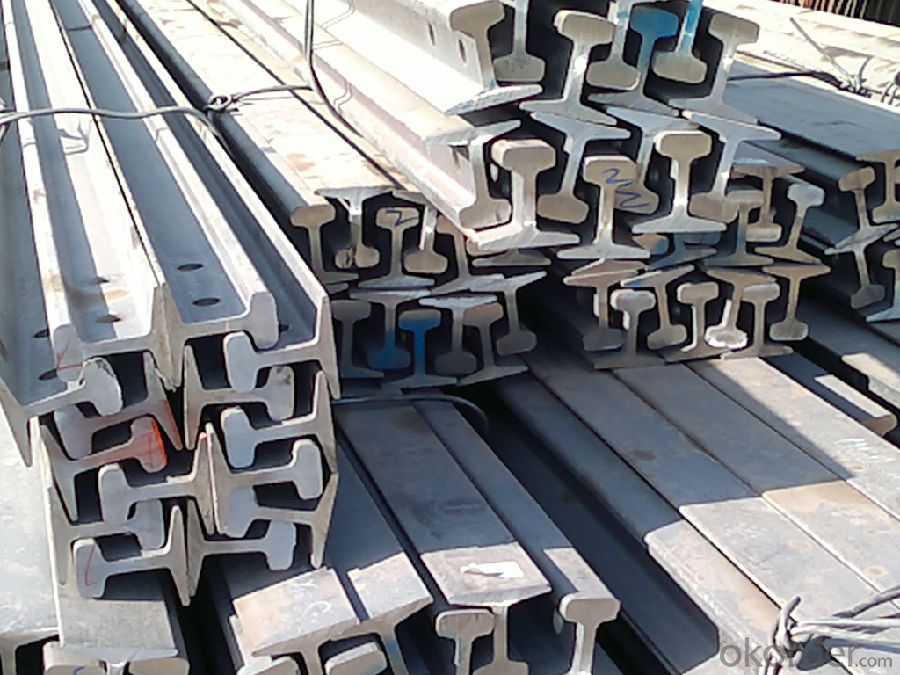
- Q:How are steel rails protected against derailments?
- Steel rails are protected against derailments through various measures such as regular maintenance and inspections, proper alignment and leveling, fastening mechanisms, and the use of safety devices like rail anchors, clips, and switches. Additionally, advanced technologies like track circuits, automatic warning systems, and continuous monitoring systems further enhance the safety and protection of steel rails against derailments.
- Q:How are steel rails tested for resistance to vibration?
- Steel rails are typically tested for resistance to vibration through a process called dynamic testing. This involves subjecting the rails to various vibrations and measuring their response. The rails are mounted on a test rig and excited with controlled vibrations of different frequencies and amplitudes. Accelerometers are used to measure the rail's response to these vibrations, including its natural frequency and damping characteristics. The data collected from these tests helps determine the rail's ability to withstand vibrations and ensures its suitability for safe and reliable railway operations.
- Q:How are steel rails protected against abrasive materials?
- Steel rails are protected against abrasive materials through a process called rail grinding. This involves using specialized grinding machines to remove any irregularities or surface defects from the rails, ensuring a smooth and even surface. Additionally, rail lubrication systems are often employed to reduce friction and prevent the accumulation of abrasive materials on the rails.
- Q:What is the average weight capacity of steel rails?
- The average weight capacity of steel rails varies depending on several factors, including the specific type of rail, its dimensions, and the intended use. However, as a general guideline, most steel rails used in railways have weight capacities ranging from 120 to 180 pounds per yard (or approximately 56 to 84 kilograms per meter). This weight capacity is typically calculated based on the maximum load that the rails can safely support without causing damage or deformation. It is important to note that rail weight capacity can also be influenced by factors such as the condition of the track, the type of train or locomotive, and the speed at which it operates. Therefore, it is always recommended to consult the manufacturer's specifications or engineering guidelines for accurate weight capacity information for a specific rail system.
- Q:What are the different types of rail joints used with steel rails?
- There are several different types of rail joints used with steel rails. One of the most common types is the bolted joint, which consists of two rail ends being connected by bolts and nuts. This type of joint is easy to install and provides a strong connection between the rails. However, it can be prone to loosening over time and may require regular maintenance. Another type of rail joint is the welded joint, which involves welding the two rail ends together. This type of joint provides a seamless and continuous connection between the rails, resulting in a smoother ride for trains. Welded joints are often used in high-speed rail systems and can be more durable and long-lasting compared to bolted joints. However, they require skilled labor and specialized equipment for installation and repair. A third type of rail joint is the insulated joint, which is used to electrically isolate sections of the track. This is commonly used in railway signaling systems to ensure proper electrical conductivity and prevent interference between different sections of the track. Insulated joints are typically made of non-conductive materials such as rubber or plastic. Lastly, there are expansion joints, which are used to accommodate thermal expansion and contraction of the rails. These joints allow the rails to expand and contract without causing stress or damage to the track structure. Expansion joints are often used in areas with extreme temperature variations and can be designed as sliding joints or hinge joints, depending on the specific requirements of the track. Overall, the choice of rail joint depends on various factors such as the type of railway system, desired level of maintenance, and specific operational requirements. Each type of rail joint has its advantages and limitations, and it is important to select the most suitable joint for a given application to ensure safe and efficient rail operations.
- Q:Are steel rails fire-resistant?
- Yes, steel rails are fire-resistant. Steel is a non-combustible material that can withstand high temperatures, making it highly resistant to fire.
- Q:How are steel rails protected from extreme temperatures?
- Steel rails are protected from extreme temperatures through a process called thermal expansion and contraction. This involves allowing the rails to expand and contract naturally with temperature changes, preventing any stress or damage. Additionally, steel rails are often coated with substances such as paint or special coatings to provide further protection against extreme temperatures and prevent corrosion.
- Q:Can steel rails be used in high-traffic rail corridors?
- Yes, steel rails can be used in high-traffic rail corridors. Steel rails are strong, durable, and can withstand heavy loads and intense usage. They are commonly used in high-traffic rail corridors around the world due to their resilience and ability to handle the demands of frequent train movements.
- Q:Can steel rails withstand extreme weather conditions?
- Yes, steel rails are designed to withstand extreme weather conditions. Steel is a durable and strong material that can withstand high winds, heavy rain, snow, and extreme temperatures. Additionally, steel rails are often treated with protective coatings to enhance their resistance to corrosion and other weather-related damages.
- Q:How do steel rails handle train vibrations?
- Steel rails are specifically designed to handle train vibrations effectively. The inherent stiffness and strength of steel help to dampen the vibrations caused by passing trains, ensuring smooth and stable movement along the tracks. Additionally, steel rails are securely fastened to the sleepers, minimizing any potential for excessive movement or oscillation. Overall, steel rails provide a robust and reliable foundation that effectively absorbs and distributes train vibrations, ensuring safe and efficient rail travel.
1. Manufacturer Overview |
|
|---|---|
| Location | |
| Year Established | |
| Annual Output Value | |
| Main Markets | |
| Company Certifications | |
2. Manufacturer Certificates |
|
|---|---|
| a) Certification Name | |
| Range | |
| Reference | |
| Validity Period | |
3. Manufacturer Capability |
|
|---|---|
| a)Trade Capacity | |
| Nearest Port | |
| Export Percentage | |
| No.of Employees in Trade Department | |
| Language Spoken: | |
| b)Factory Information | |
| Factory Size: | |
| No. of Production Lines | |
| Contract Manufacturing | |
| Product Price Range | |
Send your message to us
Mild Steel Light Rail 55Q
- Loading Port:
- China Main Port
- Payment Terms:
- TT or LC
- Min Order Qty:
- 50 m.t.
- Supply Capability:
- 5000 m.t./month
OKorder Service Pledge
OKorder Financial Service
Similar products
New products
Hot products
Related keywords
